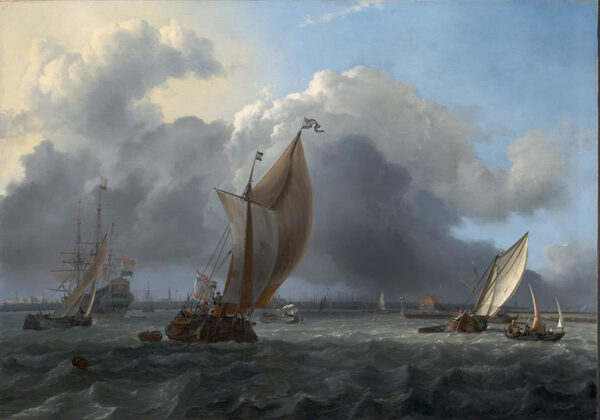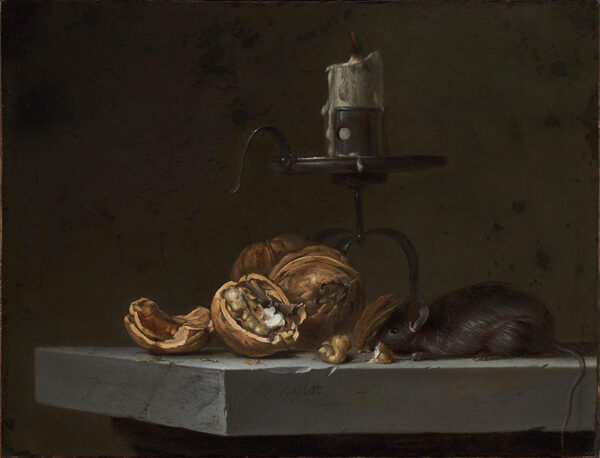
Ludolf Bakhuizen, “Ships in a Gale on the IJ before the City of Amsterdam,” 1666, Collection of the Museum of Fine Arts, Boston
Ships or still lifes? In one sense, nothing could have been more predictable: you would have to dig deep to name two genres of painting more representative of seventeenth-century Dutch art than paintings of flowers, tipped-over goblets, rough seas, stormy skies, billowy sails, and all the tell-tale symbols of a satisfied nascent capitalist society with a penchant for Tulipomania and Calvinism (and not necessarily in that order). But in one of the best shows exhibited at the Kimbell since the completion of Renzo Piano’s Pavilion in 2013, even the most predictable revealed hidden depths.
When I turned toward the ships, it became clear that Dutch Art in a Global Age, organized by the Center of Netherlandish Art at the Museum of Fine Arts, Boston, did not rehash the greatest hits of the Golden Age of Dutch painting this side of the North Sea. After a seascape of sloops and merchantmen crowding the Amsterdam harbor caught my eye, I turned to glimpse another Dutch trading vessel, but it was one that showed the show’s global scope.
Pictures of Famous Products of Mountains and Seas is a late eighteenth-century Japanese book with woodblock prints illustrating the pride and joy of the Dutch Republic’s naval prowess. This Japanese woodblock of a Dutch ship reminds us, as much as a harborscape painted on the other side of the world, that one of the characteristics of Dutch art from the storied Golden Age of the seventeenth-century Dutch Republic is its global reach. The ships teeming with botched Dutch paintings and a Japanese book tied the world together. From 1641 to 1853, Dutch merchant vessels docking at Dejima Island in Nagasaki harbor constituted the only material link between Europe and Japan. This ingenious pairing of a Japanese book with a Dutch canvas (supplemented by unusually insightful wall texts on the formation of the Dutch West Indies and Dutch East Indies Trading Companies) puts one of the most representative genres of Dutch Art in a wholly new light.
And if not ships, there were still lifes: a dozen canvases of floral arrangements and oyster shells on lugubrious green velvet. When it comes to appreciating these painterly meditations on the vanities of life, there is one rule: look closer. (Some of these paintings are so small that you have to get close.) Sometimes, there is more to the canvas than a cracked-open walnut or a wax-dripping candle. Instead, van Aelst’s 1647 Still-life with Mouse, Walnuts, and Candle on a Stone Ledge puts the life in still-life. Gnawing on a shard of walnut in half-shadows, a black mouse steals the foreground the moment you spot it. This mouse is a generic varmint — not just a nut-eating, plague-bearing, ship-borne rodent — but an intruder to this most dour and life-denying of genres. The still lifes in Dutch Art in the Global Age revealed a genre that is not so much doom and gloom with a side of flowers as rippling with life and the Earth’s variety.

Willem van Aelst, “Still-life with a Mouse, Walnuts, and a Candle on a Stone Ledge,” 1647, Collection of the Museum of Fine Arts, Boston
One of the smallest and most spellbinding paintings in the whole show was Adriaen Coorte’s 1698 miniature of five seashells. These shells, left behind by the sea creatures that once inhabited them, are reminders of former life from former ages and the transience of human existence, but also an unmitigated display of wonder in the world. Coorte’s mastery of light and color in the spikes of the shell dominating the miniature speaks to the care, the attention to detail, that makes the Dutch art from this period such a wonder to behold, and the Kimbell’s presentation of it such a success.
Dutch Art in a Global Age was no single-artist retrospective. There were more than a hundred paintings, engravings, maps, and even more artists. Rembrandt (1606-1669) hung next to his lesser-known but devilishly talented apprentice Gerrit Dou (1615-1675). Von de Velde the Elder and the Younger shared gallery space with the dramatic landscapes of Jacob Ruisdael (1628/9-1682). Nor was this show limited to Dutch subjects and satisfactions. Franz Post’s 1663 Landscape with Ruins in Olinda shows the Brazil of the Dutch West Indies Trading Company, the Brazil which Dutch traders peopled with kidnapped and enslaved Africans.
Framed by the big skies and tropical plants of the Americas, Black figures walk through the landscape: a reminder of the vast human toll that came with a Global Age that also ushered in porcelain and portraits for those who got rich back in the Dutch Republic.
Calvinist burghers were not the only ones whose likenesses were painted and etched. An engraving of French émigré philosopher René Descartes abutted an engraving of a young Black man in a heroic pose titled The Young Archer. While undertaking commissions for Amsterdam’s high and mighty, artists captured the likenesses of an unknown young man who may have been brought to Amsterdam against his will and a known French heretic. Dutch art of this period contained the world, in a way that European art had never managed before.
Dutch Art in a Global Age provided a rarity for the MFA, Boston: a show where the borrowing, small, regional museum upstages the eminence grise. Few museums that are as historically oriented as the Kimbell can compete with the Kimbell’s buildings. The spaciousness of Renzo Piano’s galleries invites wandering between still lifes, ships, frosty windmills, and silver seafood platters, all under an appropriately dim natural lighting. The Piano Pavilion unintentionally reinforced the show’s argument that Dutch Art arose in a global age. Visitors exited the show through the Kimbell’s permanent collection of Asian art. Japanese landscapes that were painted while Dutch merchantmen still dropped anchor in Nagasaki’s harbor do as much work as the wall text to express the connected world of which the Dutch were a part.
Masterpieces in the exhibit were indeed primarily from the MFA Boston, but the works drawn from the Kimbell’s own permanent collection proved to be the standouts again and again. Saenredam’s Interior of the Buurkerk, Utrecht, brought a Vermeer-like airiness that contrasted with the other paintings depicting dark rooms teeming with darkly clad congregations.
Gerrit Dou, whose theatrical fourth-wall-breaking self-portrait and miniature of a dog came from Boston, comes across as a virtuoso of a different order in the Kimbell’s Dentist by Candlelight. Historically, it has been classified as a “genre painting” for portraying the quotidian — and in this case, the dental — Dou’s dentist comes across as anything but generic. Dou’s masterful lighting (for which no digital image can do justice: another reason to make a pilgrimage to the Kimbell’s permanent collection) emanates incandescently from the candlestick the dentist is holding and burns at a dim ochre from a lamp at the foreground. The two light sources turn a discomfiting nuisance into an existential drama. Dou’s delicate hand dabs lines of care on the face of the patient’s wife: her fears become our own. All this on a panel smaller than a laptop screen.
A show on Dutch art without Rembrandt would not be much of a show, and Dutch Art in a Global Age did not disappoint. His engravings from the MFA Boston show his versatility. Before the exhibition, I hadn’t thought of Rembrandt as a landscape artist, but the Dutch meadows he etched hung next to Jacob Ruisdael’s dramatic canvases of craggy skies. Only Rembrandt could pull off a moment of humor in the Holy Family. His engraving of a preteen Jesus holding hands with his human parents is one of the show’s most engaging images. Mary appears to listen meaningfully to her firstborn (only Rembrandt would etch Mary cradling in her arms her newborn second child), while a graying Joseph looks to be suppressing a smile in a brief episode of parental discipline.
Rembrandt’s Bust of a Young Jew might be the best portrait this side of the Red River. Ordinarily displayed in the Kimbell’s Permanent Collection, the show’s curators placed it among other testimonials to the global character of religious life in the Dutch Republic. Rembrandt’s subject gazes out beyond the viewer at a display case holding a set of silver furials — the gilded caps on the Torah scroll. These were part of what made Dutch Art in a Global Age a multi-media show, and they also accomplished something far more poignant. They bore physical testimony to Amsterdam’s Jewish community. Descended from refugees of the Catholic monarchies of Portugal and Spain, the Jewry of Amsterdam would anchor Rembrandt’s hometown (and some of his best art created there) until its destruction during the Second World War. The viewer who stood between Bust of a Young Jew and the furials that may have capped a copy of the Torah that Rembrandt’s subject may very well have seen with his own eyes feels the weight of a vanished world that only existed in what Rembrandt and the now-nameless silversmith wrought.
Briefly displaced from the marble glow of Louis Kahn’s original Kimbell galleries, Bust of a Young Jew ripples with the humanity, individuality, and sensuality of a young man whom the charismatic and relatable Rembrandt has talked into playing it cool for the duration of his session. The Bust is a monument to a century of excellence of chiaroscuro and to the worldliness of Dutch Art. Yet the shadows falling on the subject’s left side scarcely cast a pall of Northern European and Calvinist gloom and doom. His left eye glints with the attention of someone who has a life to live. The two curls of hair combating the discipline of the skullcap make this portrait the most erotic in the entire show (and if there is one thing that’s missing from Dutch Art in a Global Age, it’s eros). These unruly curls evoke the luscious anastole of Alexander the Great and Hadrian’s Antinous: a Rembrandtian indication of the appeal without and the vitality within. Bust of a Young Jew beat with a quiet charisma that I’d never previously noticed in a portrait I thought I knew well.
Dutch Art in a Global Age represented what the Kimbell does best. The Kimbell is a small, regional museum that brings shows from big museums with eye-popping names (for instance the MFA Boston) and then raises the ante with its singular gifts: one of the best collections assembled in the postwar era housed in gems of postwar museum architecture. In Dutch Art in a Global Age, the kismet between the visiting exhibit and the Kimbell was on a higher plane. The pieces drawn from the Kimbell’s permanent collection made what was an interesting show from the MFA Boston, into one of the best exhibits of Dutch Art in recent memory.
Dutch Art in a Global Age: Masterpieces from the Museum of Fine Arts, Boston was on view at the Kimbell Art Museum from November 10, 2024 through February 9, 2025.







